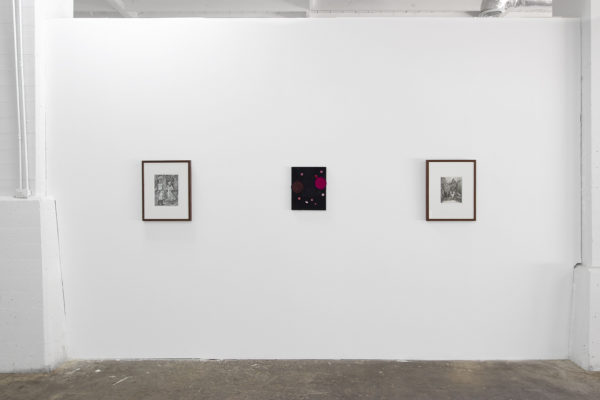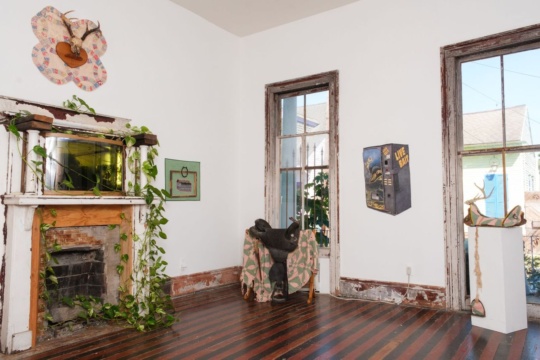
C for Courtside
513 Cooper Street
Knoxville, TN 37917
cforcourtside.com
Operated by: Eleanor Aldrich, Joshua Bienko, Eric Cagley, Lynne Ghenov, and John Douglas Powers
Opened: January 2018
Most recent exhibitions: Siren Filings, featuring Tatiana Istomina, Judy Rushin, and Mona Sharma, curated by Eleanor Aldrich (September 7 -29, 2018); Doom and Gloom, featuring Joshua Jay Johnson and Cody Tumblin, curated by Eric Cagley (August 31, 2018); Sarah Nearer Fuller Flower, featuring Rachel LaBine, Jennifer J. Lee, Calli Moore, and Risa Hricovsky, curated by Joshua Bienko (August 3 – 27, 2018)
How did you choose the name C for Courtside?
The naming of the space was the most difficult thing we’ve done. Much like the naming of a child, you’re involved in a process of trying to predict the future. We probably could have called the space “Bob” and then waited to see if it grew into a “Bob.” C for Courtside does not have a specific significance, reference, or conceptual framework. In a Kierkegaardian way, we are involved in the process of the space becoming C for Courtside as such.
Over time it has become a good metaphor for what we are trying to do: give people front row seats to experience some of the art that we, as artists, find most exciting.

Eleanor, can you say more about the current exhibition, “Siren Filings,” which you curated?
There are themes of work, women’s labor and compensation, and abuse of power throughout. One piece that became integral to the show early on is a hand-woven towel that my grandma passed down to me recently. It was made in about 1840, and after doing some research on Barbara Lahr, my ancestor who’d made it, I realized she was born two years after Karl Marx, and they grew up only 70 miles apart, practically in the same environment. She presumably had a different relationship to her work than maybe Judy Rushin does to her weavings. Judy’s work is titled The Day We Start Working for Free, intended as a comment on the gender wage gap, and another work is titled with a Russian phrase meaning “super enthusiastic and productive work.” Lahr’s work is linked to Rushin’s textiles through material and process, and it also serves as a historical and conceptual link to Tatiana Isotomina’s drawings and mixed-media works about the French Marxist philosopher Louis Althusser’s murder of his wife Hélène Rytman, a woman who is thought to have contributed to his professional career, as well as Istomina’s watercolors of Stalin’s daughter Svetlana on the lap of Lavrentiy Beria, head of the Soviet secret police. Mona Sharma‘s computer drawings and poetic documents are more mysterious, but the figure of a woman—who’s usually darker and smaller than other characters—is found in the margins or looking self-conscious throughout. The smooth forms of the digital drawings and constrictive cells of the travel documents contrast with the emotions evoked by the subject matter.
How would you characterize the contemporary art scene in Knoxville, or in East Tennessee more generally?
There is a sense that momentum is building in the area, and we’re excited to be part of that. A lot of good things are happening here, and there is lot of energy. Given the size of the city, a surprising number of artists call Knoxville home. Knoxville’s art scene benefits from UT’s School of Art and Architecture, and especially its MFA and Artist-in-Residence program. It is a self-renewing audience for places like C for Courtside. Until the last few years, space and housing were really pretty cheap in Knoxville—and still are compared to many places—so it is a good place for people who want to have time and space to work, which is why some artists stay in town after grad school.
What do you miss most about the dearly departed Knoxville alt. weekly Metro Pulse? [BA interim editor and East Tennessee native Logan Lockner completed his first editorial internship at the now defunct Metro Pulse in 2011.]
Metro Pulse was such an incredible resource for Knoxville! It covered a lot of ground—art, music, cinema, food—but it was more than just a list of things that were going on. In addition to recommendations for local events and venues, you could find thoughtful columns and even criticism. It was a nice tangible reference for all the cool things that were going on in town. C for Courtside is patiently hoping for Knoxville’s pulse to be rediscovered.









